
http://30 Superfoods For Diabetes: Lower Your Blood Sugar To Reverse Insulin Resistance And Reverse Diabetes(Eliminate Inflammation & Auto-Immune Disease) (Superfoods … insulin resistance,sugar detox diet)
Research shows that “eating a healthy diet,” coupled with exercise and maintaining normal body weight, can prevent type 2 diabetes in people who are predisposed.Choosing the right foods really does make a difference, especially if you are a diabetic.
The following superfoods contain nutrients that are especially important to people with diabetes, such as calcium, potassium, magnesium and vitamins A, C and E. They are high in fiber, which helps you feel full longer and keeps your glycemic index low so they don’t spike blood sugar .
They help maintain healthy levels of blood pressure and blood fats (like cholesterol), which are important for everyone but especially so for diabetics.
A super food is a food that contains multiple micronutrients and phytonutrients that provide health benefits. A “super meal” is a combination of super foods that help to prevent disease or heal the body from disease.

1.Blueberries

http://Blueberry Bluecrop – 1 shrub
Blueberries are a good source of vitamin K. They also contain vitamin C, fibre, manganese and other antioxidants (notably anthocyanins).
Valued for its high levels of antioxidants, some nutritionists believe that if you make only one change to your diet, it should be to add blueberries.
Blueberries can help protect against heart disease and some cancers, as well as improve your memory.
(1a) Heart health and blueberries
A study in 2012 of 93,000 women found that participants who ate three or more portions of blueberries and strawberries a week had a 32% lower risk of a heart attack compared with those who ate berries once a month or less. However, the study could not prove that these fruits definitely caused the lower risk.
(1b)Can blueberries combat high blood pressure and atherosclerosis?
While the evidence is inconclusive, it is thought that blueberries may relax the walls of the blood vessels, which may help reduce the risk of atherosclerosis – hardening of the arteries. Atherosclerosis can increase the risk of a heart attack and stroke.
A small study in 2015 involving 48 post-menopausal women, found that women who were given blueberry powder supplements over the course of eight weeks experienced a small, but clinically significant, drop in blood pressure.
A study from the same year involving 44 adults with metabolic syndrome (a combination of diabetes, high blood pressure and obesity), who were given blueberry smoothies, had less promising results as there was no effect on blood pressure.
Though it is important to note that all of these studies were relatively small which gives less “weight” to their results. They also involved different populations so the results may not be applicable to the general population.
Blueberries are low in calories and high in nutrients, including phenolic compounds with an antioxidant capacity significantly higher than vitamins C or E.
Try adding them to your breakfast cereal, including them in a packed lunch or mixing with low-fat yoghurt for a delicious dessert.
2.Beetroot

http://Premier Seeds Direct Beetroot Boltardy includes 1400 Finest Seeds
Although the leaves have always been eaten, historically the beet root was generally used medicinally for a range of ailments, including fevers, constipation and skin problems.
Beetroot is a good source of iron and folate (naturally occurring folic acid). It also contains nitrates, betaine, magnesium and other antioxidants (notably betacyanin).
More recent health claims suggest beetroot can help lower blood pressure, boost exercise performance and prevent dementia.
(2a)Can beetroot lower blood pressure?
Beetroot is rich in nitrates. When ingested, scientists believe our body converts nitrates into nitric oxide, a chemical thought to lower blood pressure. A well-conducted review of the current evidence from 2013 concluded that beetroot juice was associated with a modest reduction in blood pressure.
However further long-term trials would be needed and in people at greater risk of heart disease before we could say beetroot was clinically useful.
(2b)Does beetroot aid exercise performance?
Another well-conducted review from 2013 looked at research linking beetroot juice to improved exercise performance. The review found that inactive and recreationally active individuals saw “moderate improvements” in exercise performance from drinking beetroot juice. However, the review noted there was very little effect on elite athletes.
(2c)Can beetroot help prevent dementia?
A 2010 study suggested that a diet high in beetroot juice may increase blood flow to certain areas of the brain. However, this was a small and short-term study with several limitations and as such does not provide robust evidence that a diet high in nitrates aids cognitive function. Further research is needed in larger numbers of people over a longer period.
A 2014 study looked at the effects of beetroot juice on cyclists, who were cycling in a chamber designed to mimic the effects of relatively high altitude (2,500 meters above sea level).
Researchers found that cyclists given the juice had a modest but significant increase in terms of their time trial scores; on average there was a 16 second improvement.
Beetroot and beetroot juice, along with green leafy vegetables, cabbage and celery, are very useful as part of a balanced diet as their nitrate content may help to reduce blood pressure.
Getting active, reducing the amount of salt in your diet and maintaining a healthy weight are also key strategies for getting your blood pressure under control.
3.Goji berries

http://FloristryWarehouse Artificial Red Rosehip Berries 8mm (x288) alternative to Christmas Holly berries
These red berries are alleged to boost the immune system and brain activity, protect against heart disease and cancer, and improve life expectancy.
Goji berries contain vitamin C, vitamin B2, vitamin A, iron, selenium and other antioxidants (notably polysaccharides).
(3a)Can goji berries improve immunity, cardiovascular disease and life expectancy?
There is no reliable evidence to support these alleged health benefits. Most of the research into these conditions are small-sized, of poor quality, and performed in laboratories using purified and highly concentrated extracts of the goji berry.
(3b)Do goji berries aid wellbeing, brain activity and digestion?
One small study from 2008 found a daily drink of 120ml of goji berry juice for 14 days improved feelings of wellbeing, brain activity and digestion. However, the study involved only 34 people and was attempting to measure the effects of goji berry juice on a variety of conditions. The results of the study were inconclusive.
(3c)Can goji berries prevent cancer?
One of the most talked about clinical studies on goji berries is a 1994 Chinese study conducted on 79 patients with various advanced cancers. It found those treated with immunotherapy in combination with goji polysaccharides saw their cancers regress. Unfortunately, information on the design of the study and the goji berry compounds used are lacking, so it is difficult to fully assess the significance of the results.
Various goji berry products are sold as health foods, but the evidence of their health benefits so far comes from scientific studies using purified extracts of the fruit at much higher concentrations than the products contain.
As these products tend to be relatively costly, it makes sense to stick to eating a range of fruits and vegetables rather than spending your money on this one item with no real proven health benefits.
4.Broccoli

http://Premier Seeds Direct ORG176 Broccoli Green Sprouting Organic Seeds (Pack of 1000)
Broccoli is a good source of vitamin C and folate (naturally occurring folic acid). It also contains vitamins A, K, calcium, fibre, beta-carotene and other antioxidants (notably indole-3-carbinol and sulforaphane).
(4a)Can broccoli help prevent cardiovascular disease?
In a small study from 2012 of 81 people with diabetes, those in a group that ate 10g a day of enriched broccoli sprouts powder for four weeks saw a reduction in their levels of cholesterol and triglycerides (a type of fat found in the blood), both of which can cause cardiovascular disease.
(4b)Does broccoli help in diabetes?
In a lab study from 2008, researchers applied the antioxidant sulforaphane(found in broccoli) to human blood vessels incubated with sugar. They found that sulforaphane appeared to prevent the damage to small blood vessels caused by high blood sugar (which can happen if you have diabetes).
Broccoli contains many nutrients, such as folate, soluble and insoluble fibre, vitamins C and A, and calcium, which are needed for numerous functions in the body.
It is a member of the family of cruciferous vegetables along with cauliflower, bok choy and cabbage. These all contain compounds that are linked to improving the body’s ability to impede the growth of cancer cells.
Broccoli is a flexible vegetable that works well in salads, stir fries, curries and soups. An 80g serving will count towards your 5 A Day.

5.Garlic

http://Cottage Garden: Garlic Bulbs ‘ MARCO ‘ Allium sativum (AUTUMN Planting) – British Seed Garlic – PLANT NOW – Free UK P & P (5)
Garlic contains vitamins C and B6, manganese, selenium and other antioxidants (notably allicin).
More recent evidence-based research suggests garlic may be effective against high blood pressure, cardiovascular disease, cholesterol, colds and some cancers.
(5a) Does garlic lower high blood pressure?
An authoritative review from 2012 of the best available evidence on the use of garlic to treat high blood pressure identified one good-quality study that suggested 200mg of garlic powder three times daily reduced blood pressure.
(5b)Can garlic reduce cholesterol?
A well-conducted review from 2009 of 29 good-quality studies involving a combined total of 1,794 participants concluded that garlic – mainly garlic powder – produced “modest reductions” in total cholesterol levels.
Garlic is a delicious flavour used widely in Mediterranean and Asian cooking.
Studies using high concentrations of garlic extracts have been associated with improved blood circulation, healthier cholesterol levels and lower blood pressure, all of which reduce the risk of cardiovascular disease.
Garlic is particularly useful in cooking as it provides an alternative to salt in adding flavour to meals, along with lemon juice, chilli, herbs and spices. Eating less salt is important for avoiding high blood pressure.
6.Green tea

http://Matcha Green Tea Powder – Organic Culinary Grade – Japanese (113g)
Green tea has been used in traditional Chinese medicine for centuries to treat everything from headaches to depression.
The leaves are supposedly richer in antioxidants than other types of tea because of the way they are processed.
Green tea contains B vitamins, folate (naturally occurring folic acid), manganese, potassium, magnesium, caffeine and other antioxidants, notably catechins.
All types of tea – green, black and oolong – are produced from the Camellia sinensis plant using different methods. Fresh leaves from the plant are steamed to produce green tea, while the leaves of black tea and oolong involve fermentation.
Green tea is alleged to boost weight loss, reduce cholesterol, combat cardiovascular disease, and prevent cancer and Alzheimer’s disease.
(6a)Can green tea aid weight loss?
It’s thought the antioxidants catechin and caffeine found in green tea may have a role in helping the body burn more calories – sometimes referred to as speeding up the metabolism – which can help weight loss.
Green tea preparations used for losing weight are extracts of green tea that contain a higher concentration of catechins and caffeine than the typical green tea beverage prepared from a tea bag and boiling water.
(6b)Does green tea cut cholesterol?
A good-quality review from 2013 of 11 studies involving 821 people found daily consumption of green and black tea (as a drink or a capsule) could help lower cholesterol and blood pressure thanks to tea and its catechins.
Another good-quality review from 2011 found drinking green tea enriched with catechins led to a small reduction in cholesterol, a main cause of heart disease and stroke.
(6c)Can green tea lower blood pressure?
A 2014 survey of data from previously published studies looked at the evidence of whether drinking green tea could help lower blood pressure. There was evidence of a modest reduction in people with high blood pressure who consumed green tea.
In the Far East, green tea has been used as a treatment for a variety of conditions ranging from arthritis to weight loss, as well as a preventative measure for diseases such as cancer.
7. Oily fish

http://Naturally Sugar-Free – Fish & Seafood and Weeknight Dinners Cookbook: Delicious Sugar-Free and Diabetic-Friendly Recipes for the Health-Conscious
Interest in the health benefits of oily fish started when researchers observed that Eskimos, who mainly eat oily fish, had fewer than average heart attacks and strokes.Oily fish such as salmon, mackerel and sardines are said to help against cardiovascular disease, prostate cancer, age-related vision loss and dementia.
It’s a good source of vitamin D, protein, some B vitamins and selenium. It’s also a rich source of omega-3 fatty acids, a type of fat that is good for our health.
(7a)Cardiovascular disease
A large body of evidence suggests that fish consumption, particularly oily fish, reduces the risk of cardiovascular disease.
Studies have found eating oily fish can lower blood pressure and reduce fat build-up in the arteries. The evidence is strong enough to warrant a government recommendation that we eat at least two portions of fish a week, one of which should be oily.
(7b)Vision
A well-conducted review in 2010 found there was some evidence that eating oily fish two or more times a week could reduce the risk of age-related macular degeneration , a common cause of blindness in older people.
(7c)Rheumatoid Arthritis
A 2013 study looked at the eating habits of around 32,000 middle-aged and older women to see if oily fish consumption had any influence on them developing rheumatoid arthritis. They did find that women who ate one or more servings of oily fish were 29% less likely to develop rheumatoid arthritis than women who never, or very rarely, ate oily fish.
If there’s one food that’s good for your heart, it’s oily fish.
The benefits of eating at least two portions of fish a week, including one of oily fish, include keeping your blood pressure at a healthy level and improving blood lipids, both of which reduce your risk of cardiovascular disease.
Remember that you can get your omega-3 from a range of oily fish. Tinned sardines and mackerel, for example, are an easy and cheap way to stock up the store cupboard. Eaten on wholewheat bread or toast with a side salad, this makes a quick, easy and nutritious meal.
8.Pomegranate

http://100g | DRIED POMEGRANATE SEEDS **FREE UK POST** ANARDANA TOPPING CEREAL BREAKFAST ANTIOXIDANT SWEET TANGY FRUIT VITAMIN C
Pomegranate and its distinctive ruby-red jewel-like seeds have been used for medicinal purposes for thousands of years.
The Middle Eastern fruit is claimed to be effective against heart disease, high blood pressure, inflammation and some cancers, including prostate cancer.
Pomegranate is a good source of fibre. It also contains vitamins A, C and E, iron and other antioxidants (notably tannins).
(8a)Can pomegranate strengthen bones?
A 2013 study found evidence that pomegranate strengthened bones and helped prevent osteoporosis. The catch was the study involved mice, not humans.
While the biology of mice and humans are surprisingly similar, we can never be sure that these results will be applicable to us.
(8b)Can pomegranate reduce Cholesterol?
A study from 2004 on people with high cholesterol found that a daily 50ml (1.7oz) glass of pomegranate juice over three years reduced the damage caused by cholesterol in the artery by almost half, and also cut cholesterol build-up.
(8c)Is heart disease prevented by pomegranates?
A well-conducted trial from 2005 on 45 patients with coronary heart disease demonstrated that a daily 238ml (8.4oz) glass of pomegranate juice administered over three months resulted in improved blood flow to the heart and a lower risk of heart attack.
A 150ml glass of pomegranate juice counts as one of your 5 A Day. Make sure to avoid brands with added sugar. You could also add pomegranate seeds to cold dishes and salads. It’s a healthy and appetising way to increase the nutritional value of your meal.

9.Steel-cut oats

http://Bob’s Red Mill, Gluten Free Steel Cut Oats, Whole Grain, 24 oz (680 g)
You may not think of oatmeal as a superfood, but it can help reduce the risk of developing type 2 diabetes. Oatmeal contains high amounts of magnesium, which helps the body use glucose and secrete insulin properly. An eight-year trial showed a 19 percent decrease in type 2 diabetes’ risk in women with a magnesium-rich diet, and a 31 percent decreased risk in women who regularly ate whole grains.
Steel-cut oats are just as easy to cook as quick-cooking oatmeal, but when grains are left whole they are filled with the fiber, nutrients, and bound antioxidants that challenge digestion in a good way, allowing blood sugar to remain more stable.
10.Olive oil

http://Iliada Extra Virgin Olive Oil 3 Litre Tin
Following a Mediterranean-style diet rich in olive oil helps reduce the risk of type 2 diabetes by as much as 50 percent compared to a diet low in fat, according to a recent Spanish study. Researchers found that olive oil improved satiety the most when compared to lard, butter, and rapeseed (canola) oil.
In addition to being a standout source of health-promoting monounsaturated fats, olive oil is also rich in antioxidant nutrients that protect cells from damage, and prevents the development of heart disease.
11.Psyllium husk

http://Buy Whole Foods Psyllium Husks 500 g
This fiber supplement, long used for constipation relief, is proven to help people with diabetes control blood sugar better. A 2010 review from the University of California, San Diego, confirms this benefit. People who took psyllium before a meal saw their post-meal blood sugar levels rise 2 percent less than those who didn’t use the supplement.
Researchers recommend waiting at least 4 hours after taking psyllium before taking medications, because psyllium can decrease their absorption.
12.Cannellini beans

http://Buy Whole Foods Organic Cannellini Beans 1 Kg
Packed with protein and cholesterol-lowering soluble fiber, legumes such as tender, white cannellini beans are slow to raise blood sugar.
I was in Carrick-on-Suir yesterday getting a beauty treatment done in a lovely Beauty Salon called A New U!
See below a selection of photos of A New U Beauty Salon!



I use to go to another Beauty Salon in Waterford called Sam Mc Cauleys Beauty Salon!
I was surprised to hear that they were closing down as all the ladies that worked there were very good at their job!
Unfortunately it closed around Christmas time and I decided to try out A New U Beauty Salon as Carrick is only about fifeteen minutes drive from my house in Mooncoin!
There was a lovely young lady who did my beauty treatment she was called Makella!
This was the first time I had met her and she reminded me of another Beautician in Sam Mc Cauley’s Beauty Salon who was also called Makella who was very friendly and chatty too!
The Makella in A New U had loads of interesting news!
She told me about a time when she went on a school trip to the Waterford Glass Museum and she saw a play with people dressed up in old fashioned clothes dating back to Waterford in the Old Times!
She thought the play was great and was very enthusiastic about it!
I was in the Waterford Crystal Museum not long ago myself and I never saw the play Makella was talking about!
How about you did you see this play with people dressed up in old fashioned clothes and what did you think?
I told her I was at Waterford Crystal too a few weeks ago and I thought it was really good that all the different types of Crystal looked amazing!
She said that she had been there but not for many years and I told her that she should go and have a look again in Waterford Crystal as it is for free!
I told her I thought that she should go back soon and have a look again at the lovely Crystal!
I had a great time at the Waterford Crystal Museum,I went there one Thursday afternoon for a look around!
There was a lot of tourists around especially Americans and Makella said the same thing that when she went to the Waterford Crystal Museum on her school trip there was a lot of tourists!
I parked my car near Avondale Townhouse Luxury Guest Accomodation on my way to Waterford Crystal Museum!
See below a selection of photos of Avondale Townhouse!
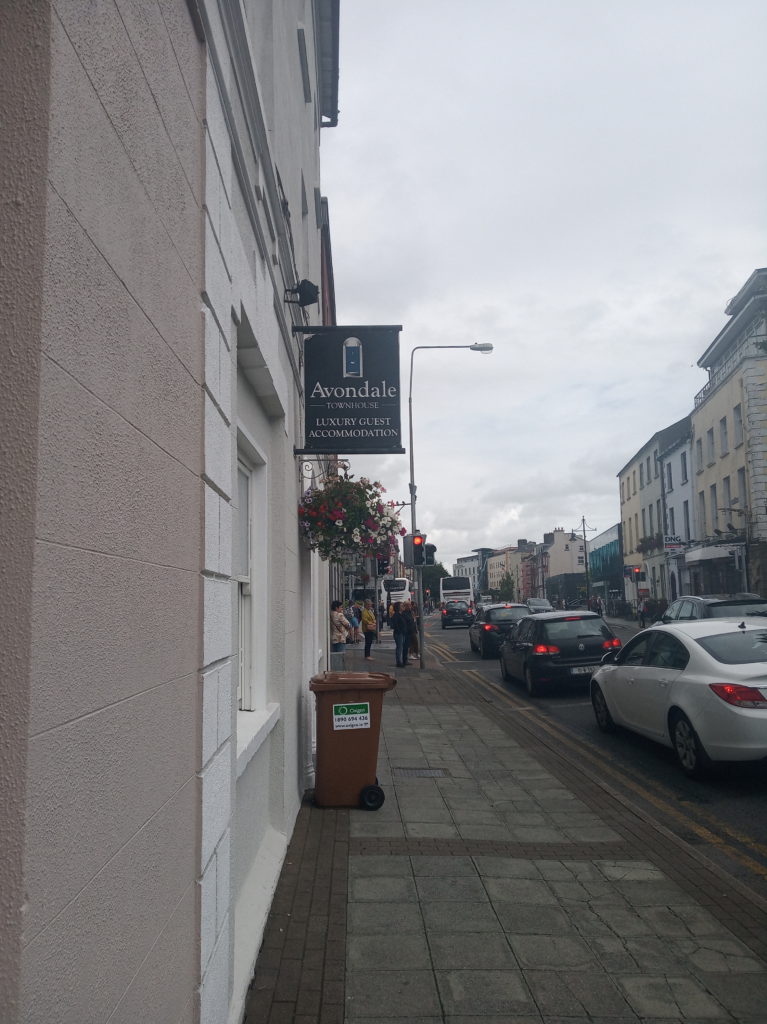
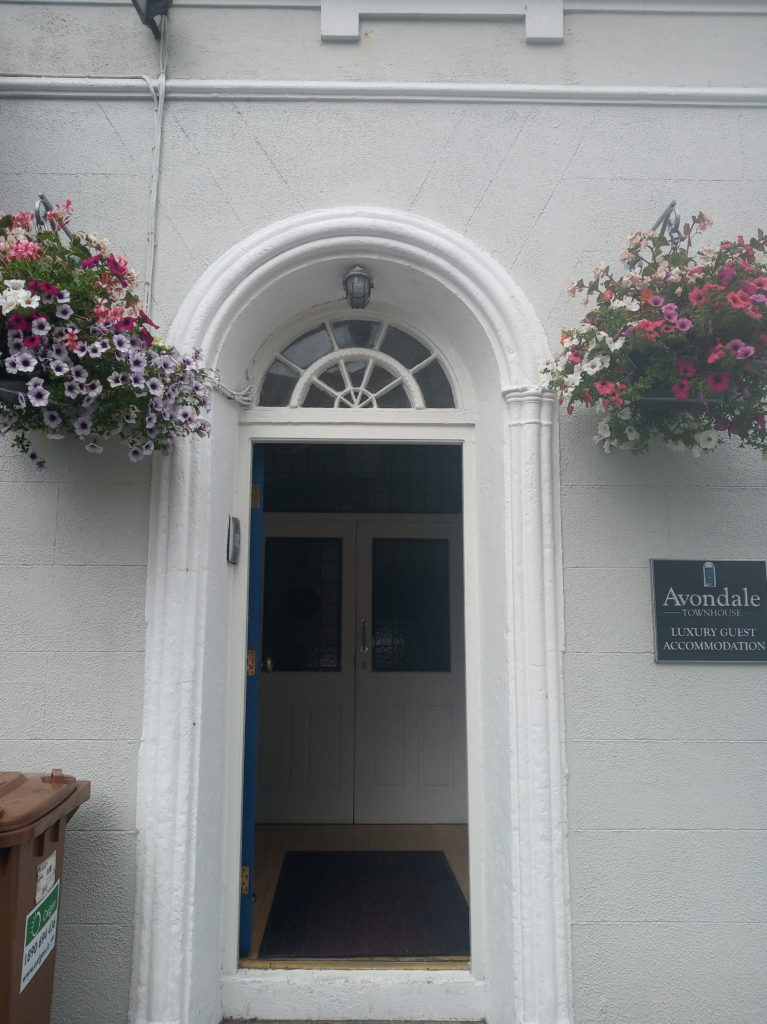
The next place I came to was the traffic lights where a group of young men were having a chat!

I crossed over to the other side of the road and took some lovely photos of Waterford Crystal Museum!
See below a selection of these lovely photos!



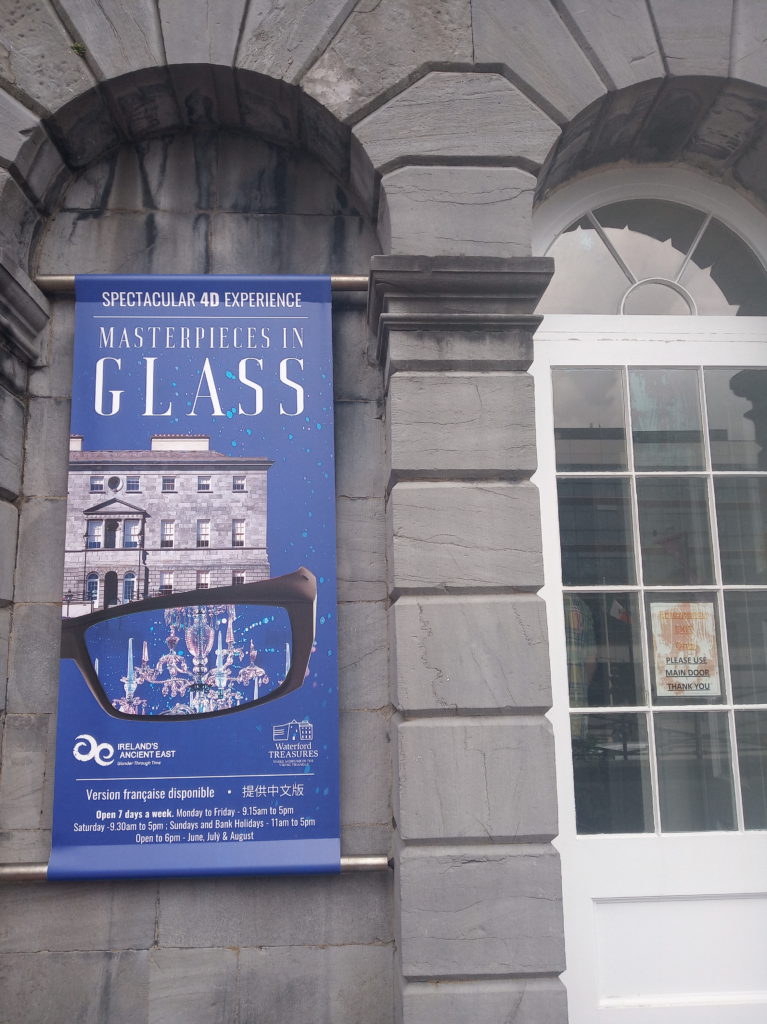

I entered the Waterford Crystal Museum and it was fairly crowded with tourists!
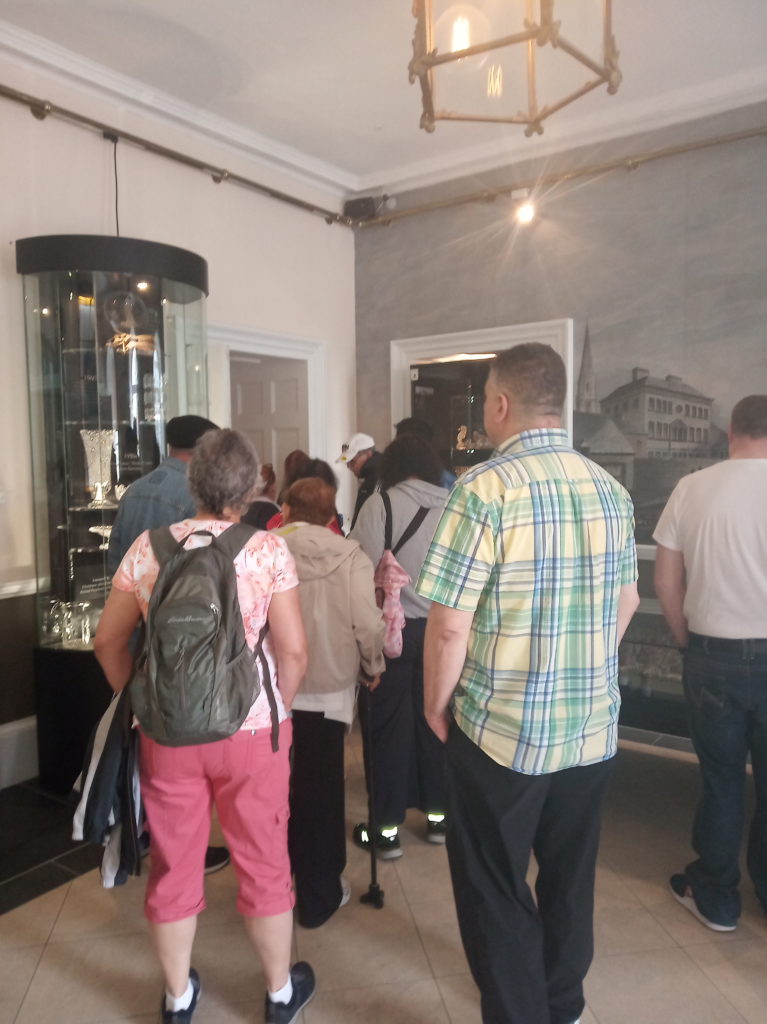
I saw a lot of beautiful museum pieces in the Waterford Crystal Museum!
See below a selection of them!



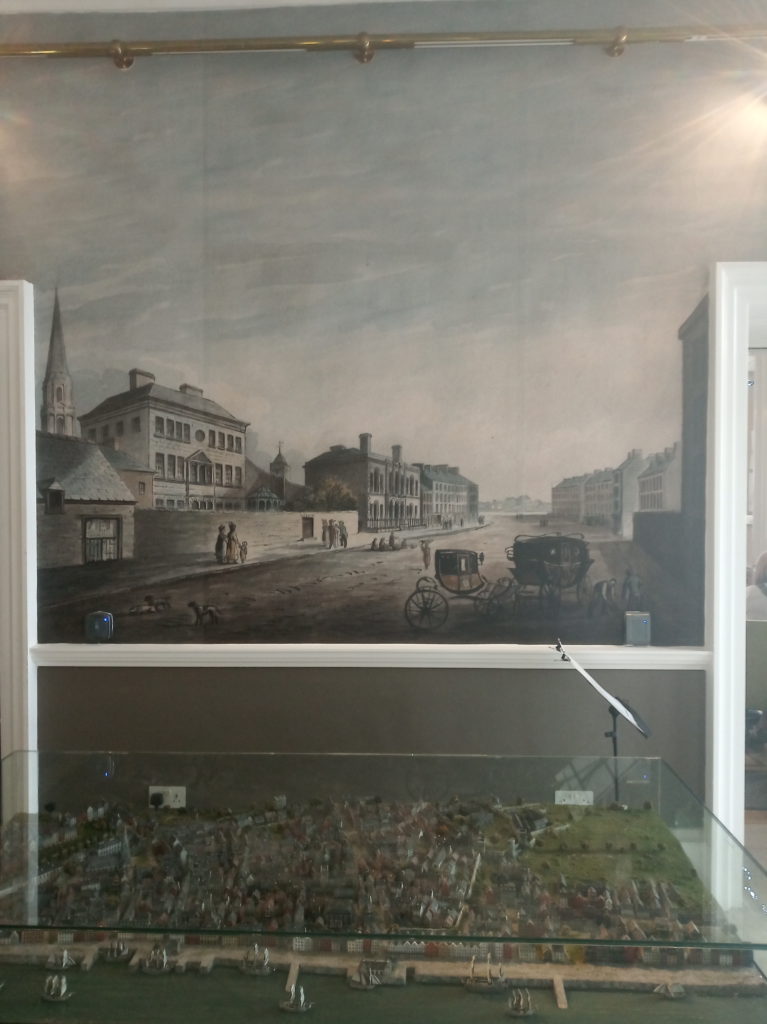
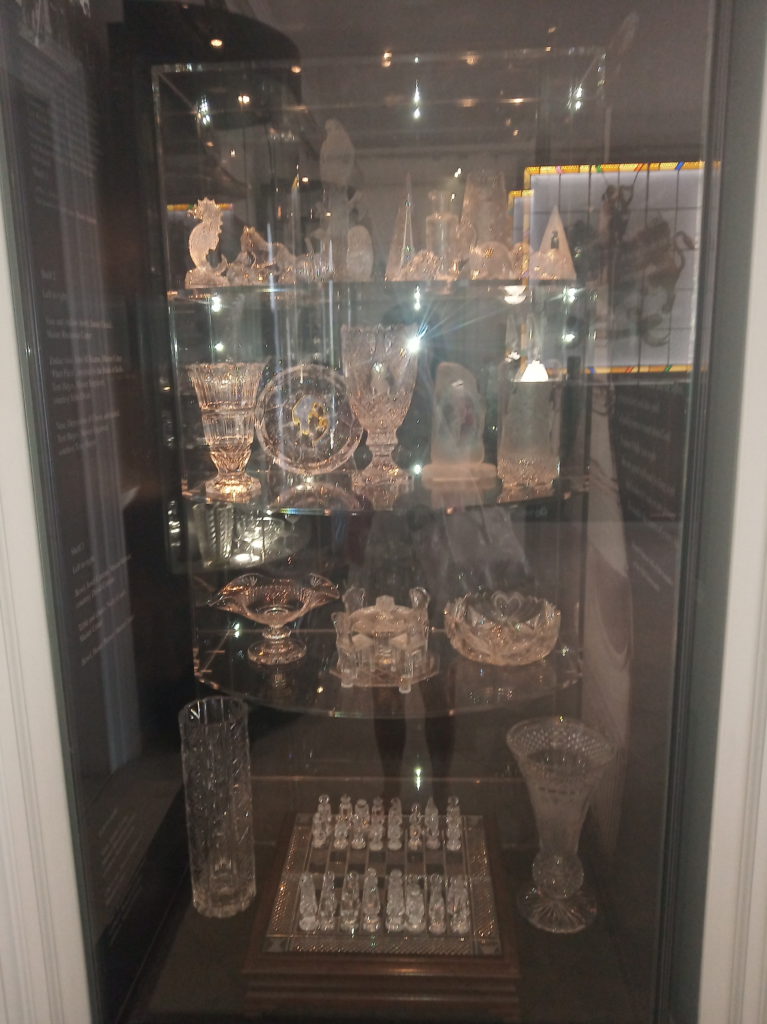
I then saw a door to my left where there were a lot of people eating and as I was feeling hungry I thought I would have a look at their menu outside!

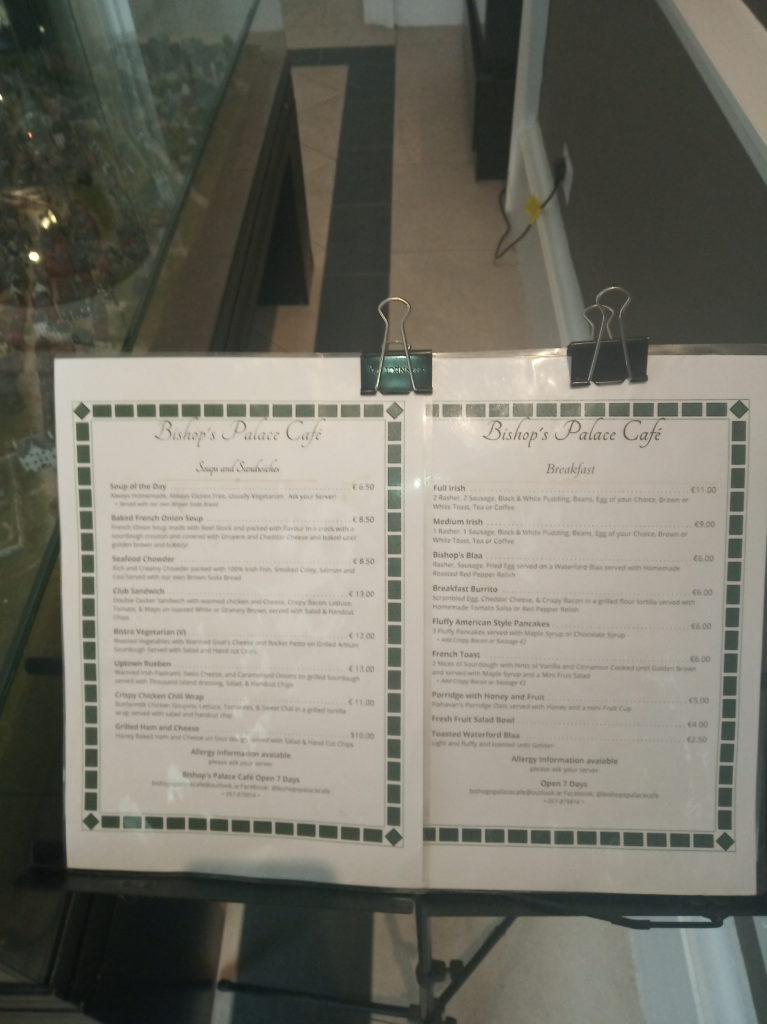
I then went into Bishop’s Palace Cafe and took a seat next to a very attractive lady!
I ordered their potato and leek soup with homemade brown bread!
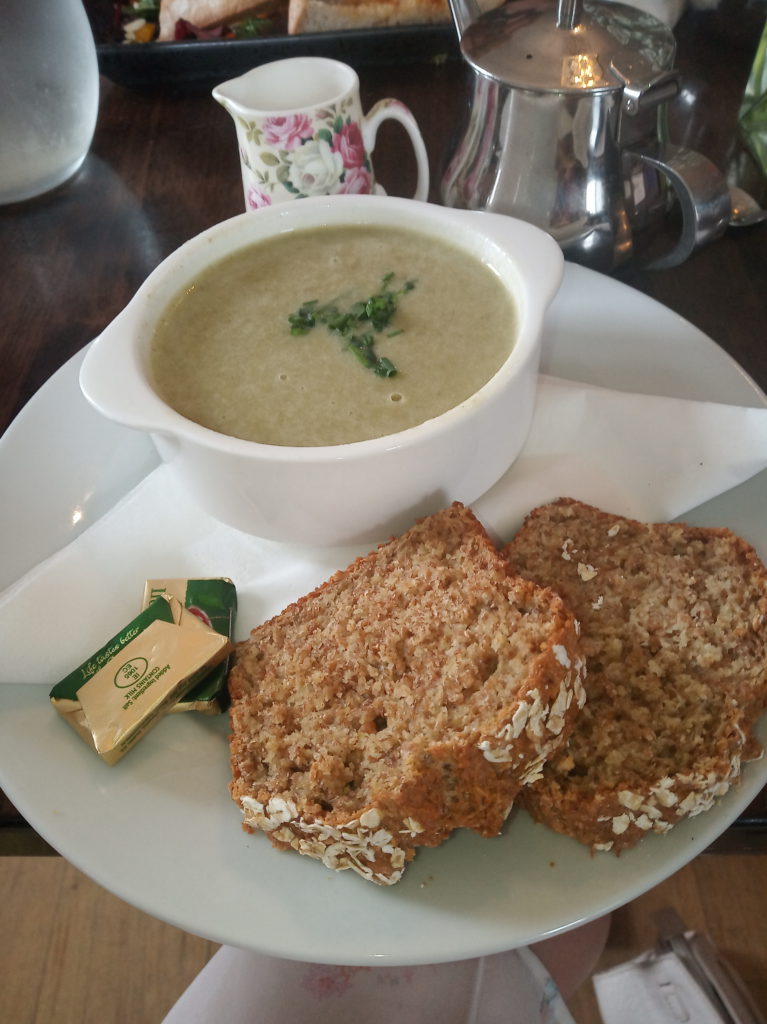
I thought the homemade brown bread was delicious and the soup was lovely too!
I only eat one slice of the brown bread though as two slices would be too much carbohydrate!
I kept the other slice of brown bread for later on!
The lady across from me told me she was eating a healthy walnut salad and she said it was delicious!
She was very friendly and helpful and I had got a parking ticket the day before and she gave me directions to the Parking Fine Office!
I then went into the ladies and gave myself four units of novorapid ,two units for the homemade brown bread and two units for the potato and leek soup!
I then went out of Bishop’s Palace Cafe and went back into the museum to finish my tour!
I then passed a man viewing a selection of postcards!

I then continued on my tour,see below another selection of Waterford Crystal Museum pieces!

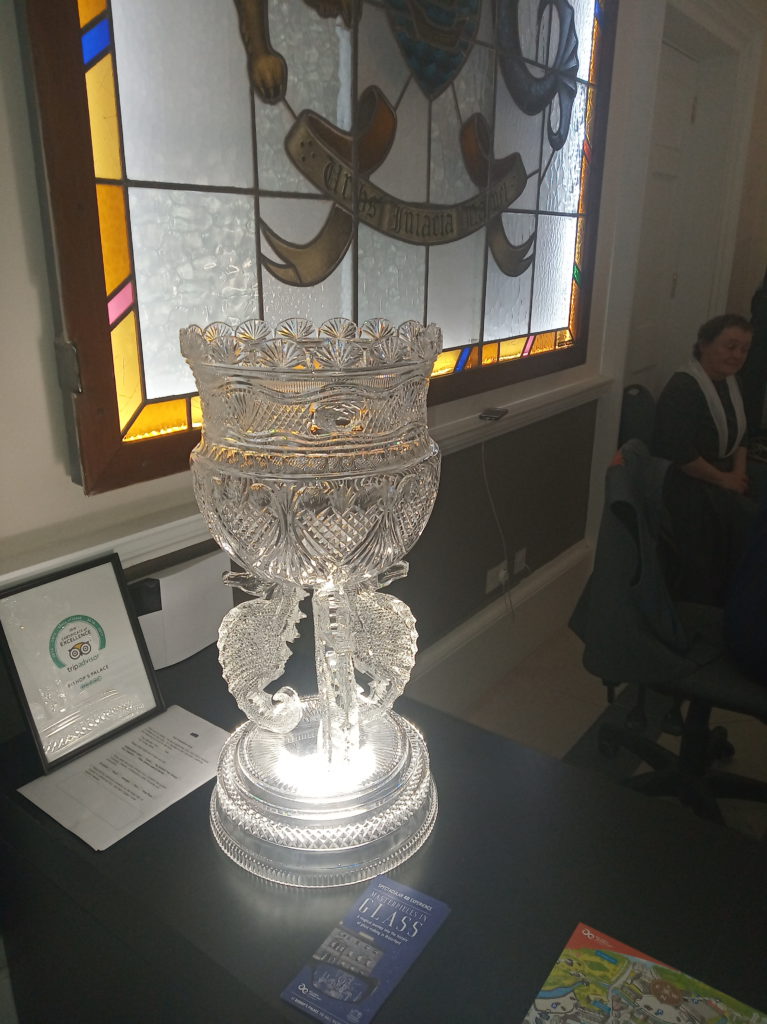

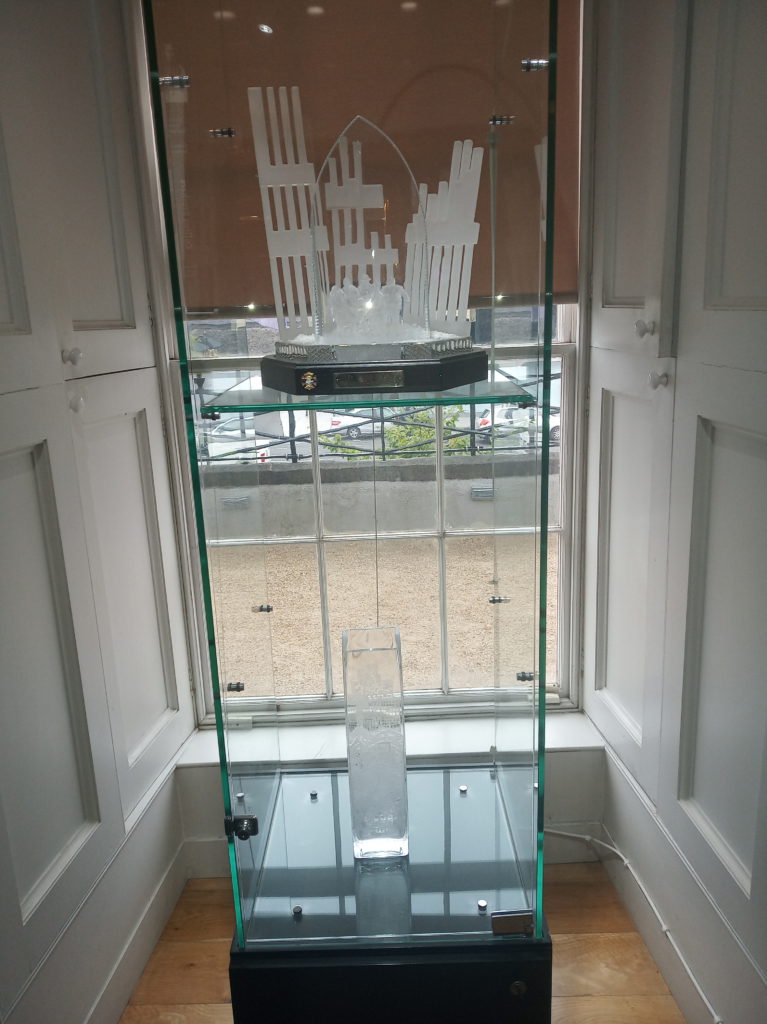
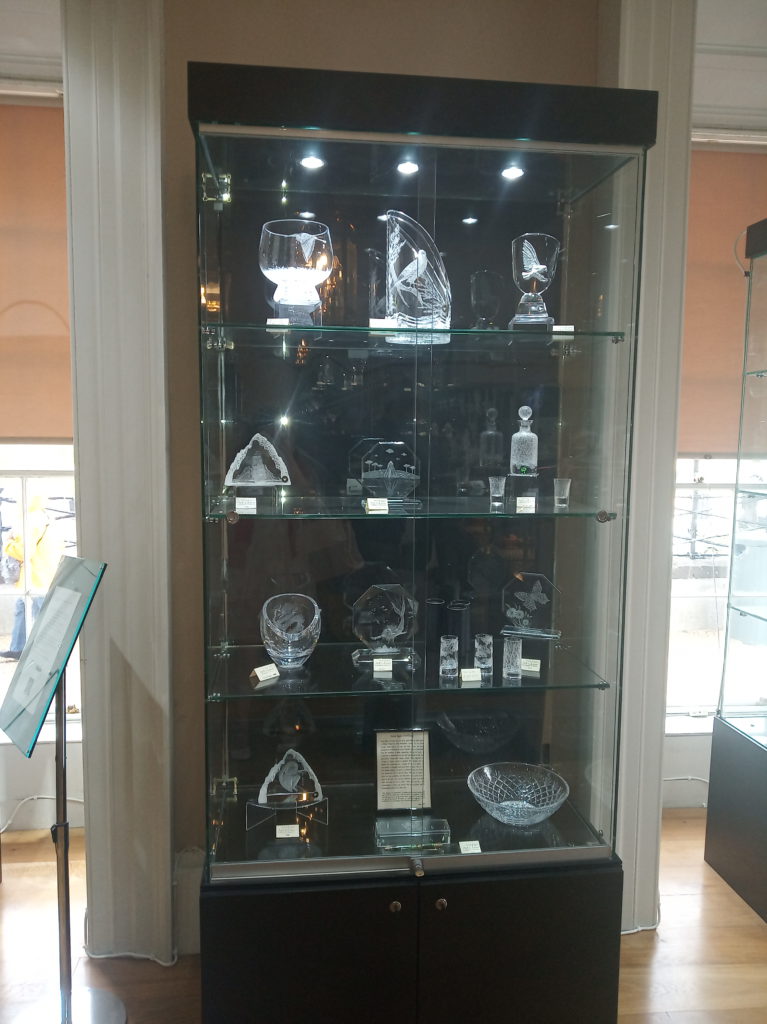
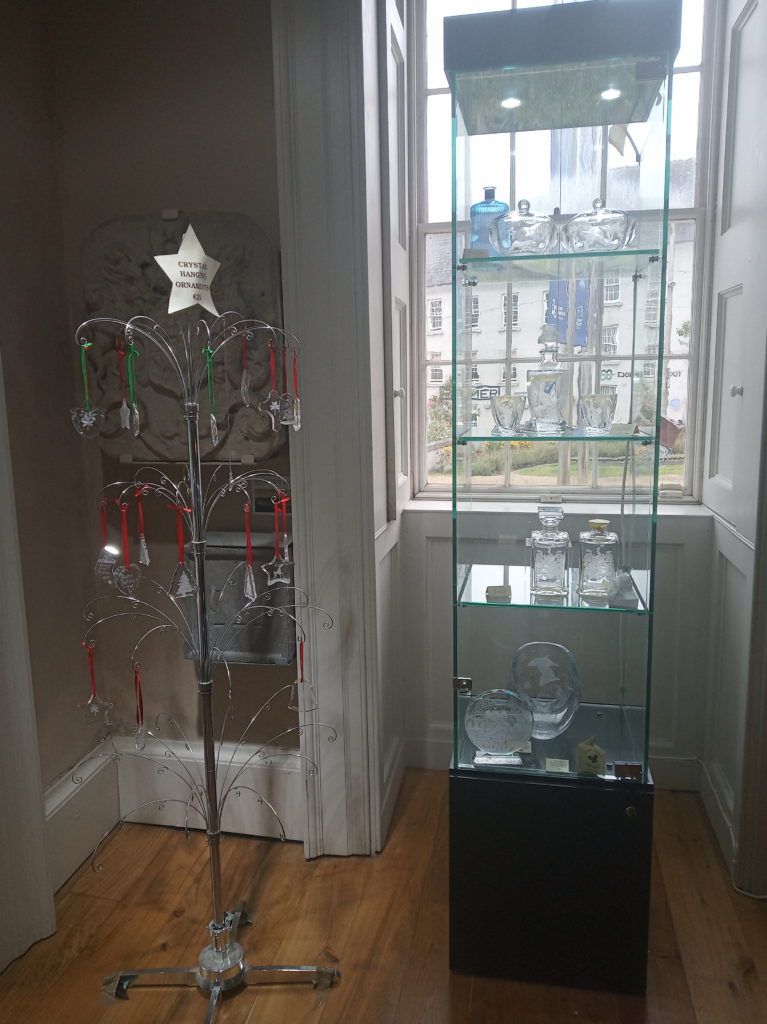
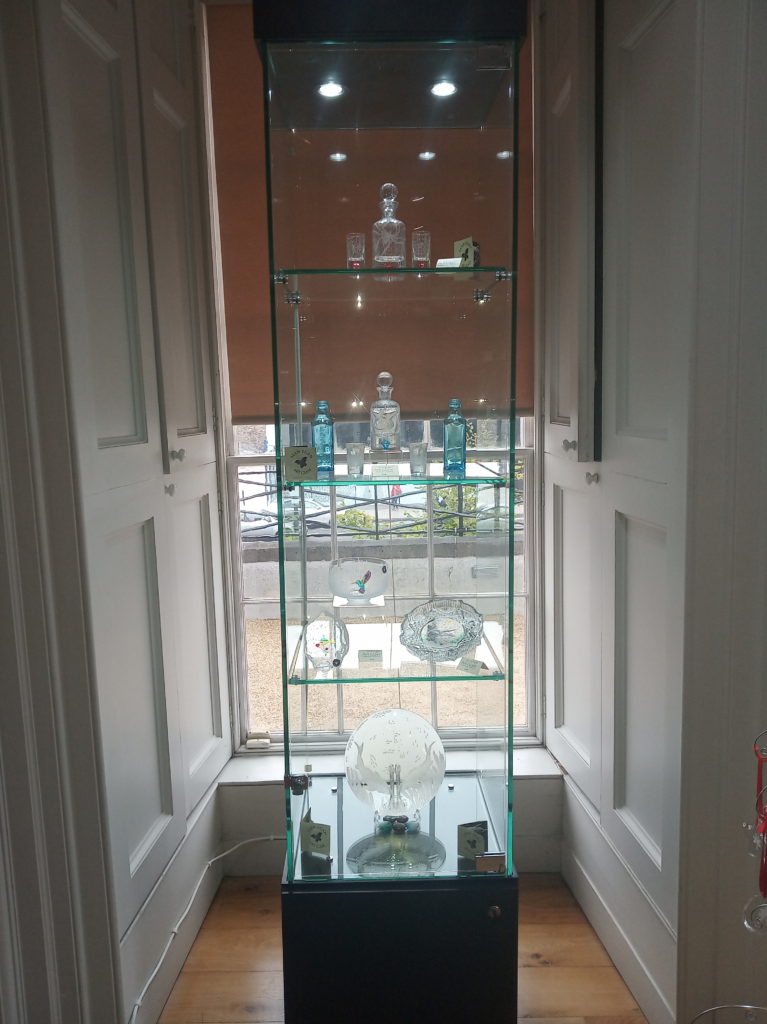
Next I saw a man engraving the Waterford Crystal with specialised engraving tools!
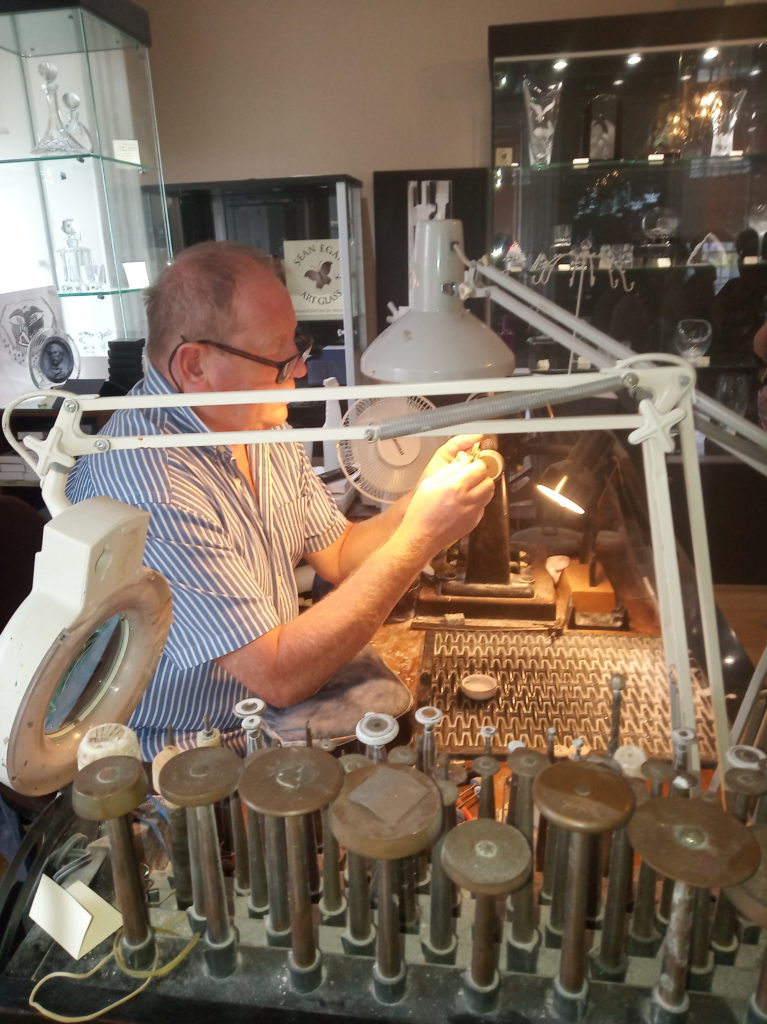
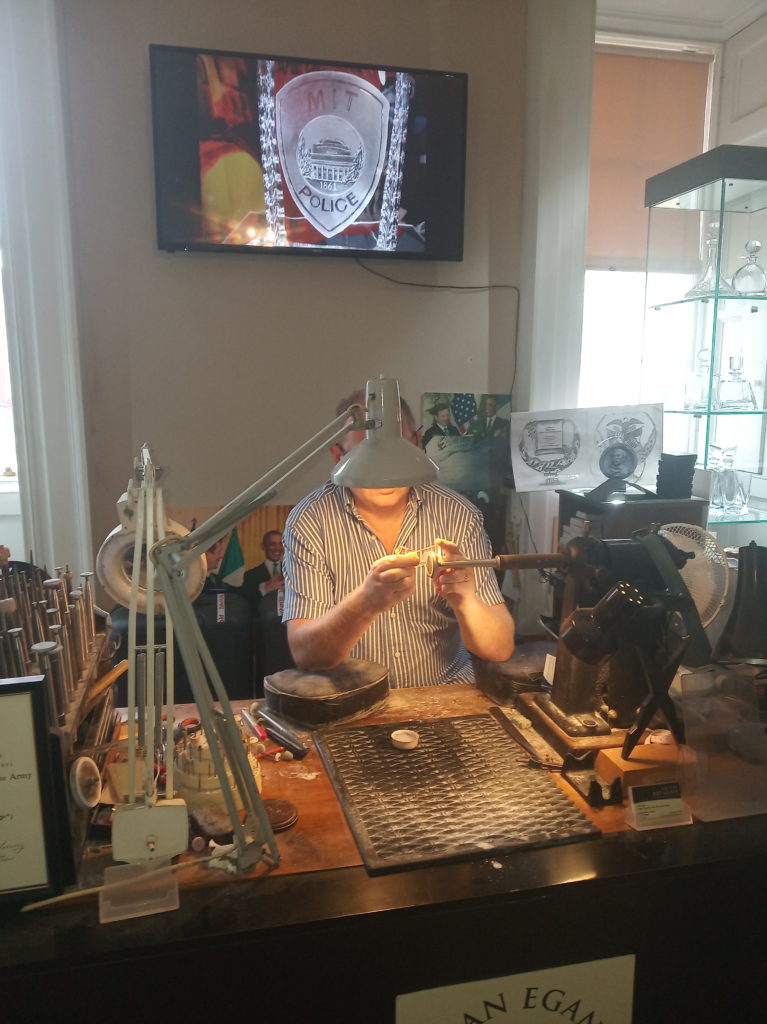
Next I came across lovely museum pieces of the Band Of Brothers!
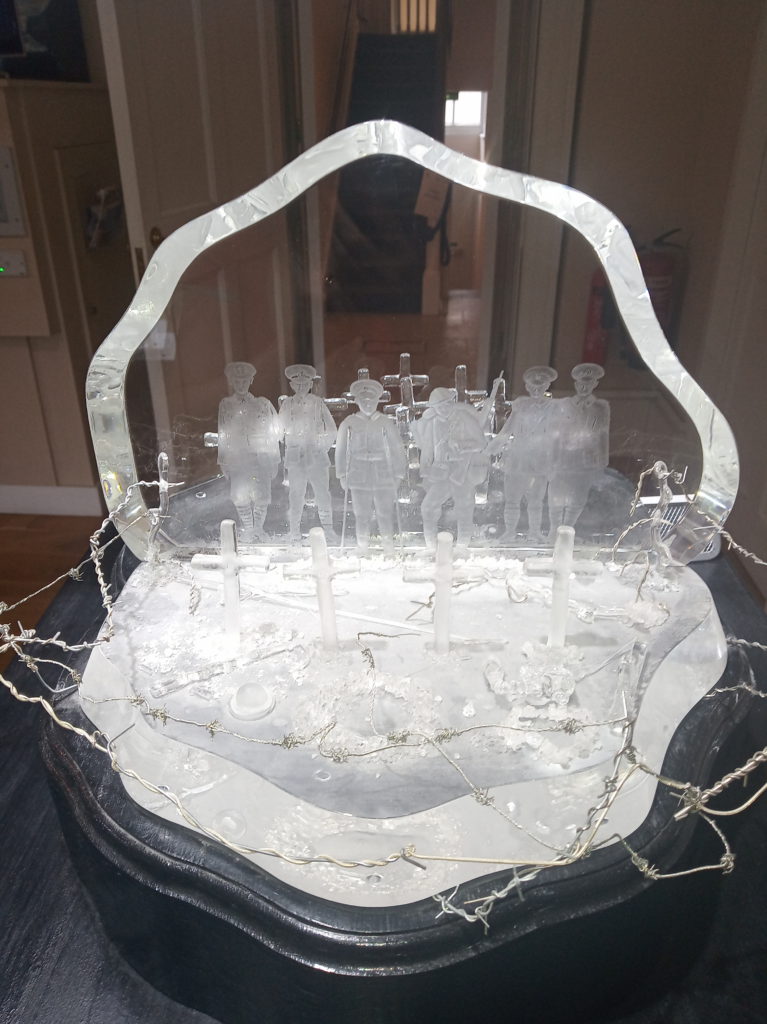
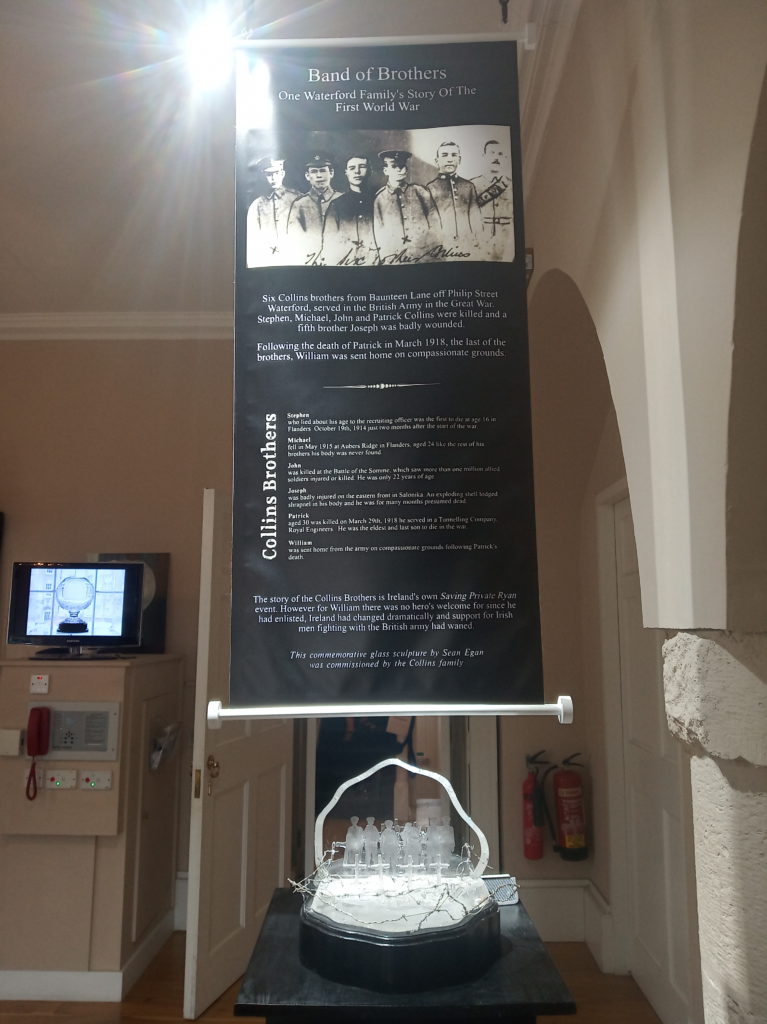
I was going for a walk near my house in Mooncoin when I met a smartly dressed man in uniform!
I told him I thought he looked well and I liked his tie and he told me he had been at a Navy function!
He told me he hadnt been part of the real Navy he had been a member of the Navy Reserve!
He mentioned World War One and about how he had a friend who had been honoured with some medals and he was going to wear them tomorrow at another navy function!
I met him at the railway station near my house in Mooncoin,see below a photo of this railway station!

Do you have any military medals and if so can you let me know what for as I would love to hear about them!
I think that people who are part of any military force must be very courageous!
Makella also told me that she was going to a holiday in Portugal and she was really looking forward to it!
She said one half would be old full of culture and history which she seemed to like and one half would be full of fun and sunbathing!
She also said she planned to visit some caves in Portugal and I told her that I went to Malta for my honeymoon and I saw some caves there too!
I told her Malta was a lovely country and there was a lot of history and culture there too!
Makella also told me about there being a Harvest Festival in Waterford as she had saw people setting up the stalls that morning!
As I am very interested in Healthy food I was very happy to hear that so I decided after my Beauty treatment with Makella to go to Waterford to see the Harvest Festival which I really enjoyed!
13.Spinach

http://Premier Seeds Direct LO-MT3B-C3F1 10g Spinach Perpetual Seeds (Pack of 500)
Spinach is one of many leafy greens that have been shown to drop the risk of developing diabetes.
People who consume more than one serving a day of spinach and other leafy greens slashed their risk by 14 percent, compared to people who ate less than 1/2 a serving daily, found one British study.
This green is particularly rich in vitamin K, along with several minerals including magnesium, folate, phosphorus, potassium, and zinc. It’s also a good source of the plant chemicals lutein and zeaxanthin, and various flavonoids.
Although spinach is technically a rich source of calcium, another nutrient in spinach called oxalic acid prevents much of that calcium from being absorbed, but you can blanch spinach (boil it for just one minute) to reduce this chemical.
14.Sweet potatoes

http://Easy to Make Sweet Potato Recipes: 25 Recipes Guaranteed to Make Them Beg for More
One analysis found that sweet potatoes reduce HbA1c measures between 0.30 and 0.57 percent and fasting blood glucose by 10 to 15 points. Sweet potato also contains anthocyanins, which are the natural pigments that give the sweet potato its deep orange color and the antioxidants believed to have anti-inflammatory, antiviral, and antimicrobial qualities.

For more great Health and Nutrition Tips refer to the website positivehealthwellness.com.
15.Walnuts

http://Walnut Kernals – 1kg
The most widespread tree nut in the world, walnuts contain the polyunsaturated fatty acid called alpha-linolenic acid, which has been shown to lower inflammation.
The L-arginine, omega-3s, fiber, vitamin E, and other phytochemicals found in walnuts and other tree nuts make them potent: scientists have found them to have antioxidant, anticancer, antiviral, and anti-high cholesterol actions.
These powers can help stop and reverse the progression of chronic conditions such as diabetes and heart disease.
Snack on walnuts in their shells; the time it takes to crack them open can help you slow down, so your body has more time to register the food and you feel full with fewer calories.
16.Cinnamon

http://250g Bag of Cinnamon Sticks 8cm length Christmas Floristry Product
Several studies show that this delicious spice can help reduce blood sugar levels! One, study noted how people with type 2 diabetes who’d taken one or more grams of cinnamon daily had dropped their fasting blood sugar by a whopping 30 percent, compared to people who took no cinnamon. They also reduced their triglycerides, LDL cholesterol, and total cholesterol by upwards of 25 percent.
Here’s why: Cinnamon is rich in chromium, a mineral that enhances the effects of insulin. It’s also loaded with polyphenols, antioxidants that gather up all the free radicals in your blood to protect you from cancer and also lower systemic inflammation, further guarding you from diabetes and heart disease.

17.Collard greens

http://Premier Seeds Direct COL02 Collards Vates Green Finest Seeds (Pack of 500)
Dark green leafy vegetables like collard greens are excellent sources of vitamin C, which helps lower cortisol in the body and consequently reduces inflammation as well.
Collard greens (and other cruciferous veggies like kale and Brussels sprouts) are also a good source of alpha-lipoic acid (ALA), a micronutrient that helps the body deal with stress.
Good news for Diabetics alpha-lipoic acid (ALA) also helps reduce blood sugar levels and can help to strengthen the nerves damaged by diabetic neuropathy!
Just be careful not to overcook it, which creates a strong sulfur smell. Just five minutes of steaming, and you’re done.
18.Turmeric

http://
Curcumin, the active ingredient in turmeric, is the compound believed to regulate fat metabolism in the body.
Curcumin acts directly on fat cells, pancreatic cells, kidney cells, and muscle cells, dampening inflammation and blocking the nefarious activities of cancer-causing tumor necrosis factor and interleukin-6.
Experts believe the combined action of all of these factors together gives curcumin the power to reverse insulin resistance, high blood sugar and high cholesterol, and other symptoms linked to obesity.
19.Tomatoes

http://Tomatoes: A Gardener’s Guide
Tomatoes are full of lycopene, a powerful substance that may reduce the risk of cancer (especially prostate cancer), heart disease, and macular degeneration, an eye disease that causes blurred vision.
Enjoy them raw or cooked tomatoes are nutritious in both their natural and cooked state!
Like other non-starchy fruits, tomatoes have a low GI ranking of 55 or less.
People found that eating 200 grams of raw tomato each day reduced blood pressure, people concluded tomato consumption helps reduce cardiovascular risk that’s associated with Type 2 diabetes.
For more great Health and Nutrition Tips refer to the website positivehealthwellness.com.

If you have any information,questions, or feedback you would like to include in this post.
Please email momo19@diabetessupportsite.com or leave your comments below.






























































































































































